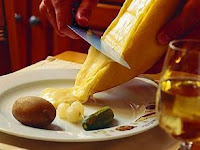 |
| Brindamour |
 |
| Brin d'Amour |
Brindamour is an herb covered sheep's milk cheese produced on the island of Corsica. It is also known by the name Fleur du Maquis (flower of the maquis) which references the ubiquitous brambly underbrush that covers the island. This cheese is Corsica's most famous cheese and is made entirely by small independent farms and dairies. It is transported in bulk to the major markets on the French mainland for distribution around the world. Brin d'Amour is usually made from unpasteurized sheep's milk but the cheeses you will find in the United States will almost always be the pasteurized version due to its short aging time. These versions are usually called Fleur du Maquis . Both versions are very good so this is not a major issue.
Details: Brindamour is a rindless cheese that is densely covered with dried herbs which impart their flavors to the cheese. It is shaped into round edged squares or round disks that weigh about 1.25 to1.75lbs each. The types of herbs used varies by the producer but they are always locally grown. The most popular herbs being used are rosemary, thyme, and savory, in addition to juniper berries, and coriander seeds.
Flavor: When Brindamour arrives in the US it is young and has been aged for about two weeks. The inner paste will be pure white, soft and moist but not wet and will have a mild flavor. It can be bought this way, but many cheese sellers let it age for one to two months to develop its true flavor. At one month the interior paste will be bone white and a bit runny and will have taken on a nutty sheepy flavor. If you find Brin d'Amour with faded and dried out herbs it will feel harder because the interior paste has thickened. At this point it will be close to two months old and will have lost most of its moisture. The flavor will have evolved and will now be much stronger but not extremely sheepy and the herb flavor will be more pronounced. This is a great cheese at this stage.
The entire cheese is edible but the coating of herbs can be tough to chew through so just scrape them off. You may see spots of mold on older versions but they can easily be scraped off.
French Cheese Sampler At Amazon
When shopping for Brindamour ask your cheese retailer approximately how old the cheese is so you can get the age that you want. Remember all stages of ripening are wonderful and you may want to try them all to see which ones you prefer. This is a hearty cheese but ask for a sample to see if the age is right for you. Do not be turned off by the faded color of the herbs or specks of mold, as noted above this is a natural process of aging and it will give you an indication as to how old it might be. NOTE: You may also find another Corsican cheese like Brindamour named Niolo, it is not very common but a few really good gourmet cheese shops may some in stock.
Serve Brindamour at lunchtime as a salad course that contains olives, tomatoes, ripe fresh peppers and savory greens. This is also a great table cheese served with a glass of wine.
Wine Pairing: Sharp earthy reds from Corsica like Sciacarello and Patrimonio if you can not find them look for similar reds from France and Italy.
